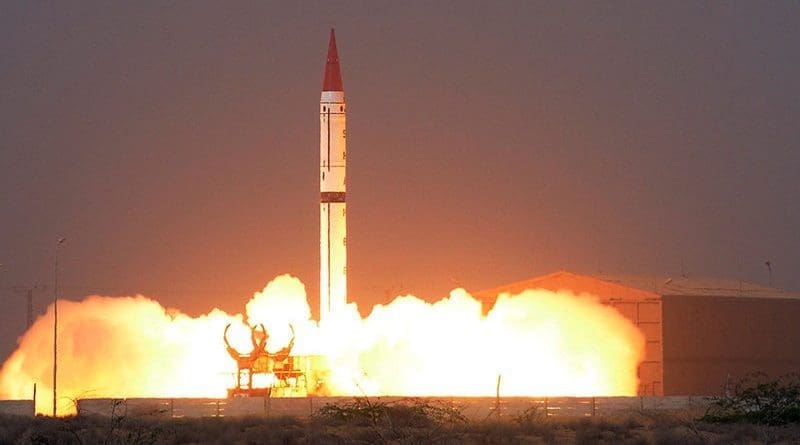Shaheen-III Test: Pakistan Maintaining Deterrence Stability In South Asia – OpEd
Pakistan conducted a successful flight test of Shaheen-III Surface-to-Surface Ballistic Missile, with a range of 2,750 kilometers, which makes it capable of reaching the farthest point in India’s northeast and Andaman and Nicobar Islands. It is solid-fuelled and equipped with the Post-Separation Altitude Correction (PSAC) system. Solid fuel is suited for rapid response capabilities, while the PSAC feature provides it the ability to adjust the warhead trajectory for greater accuracy and evading anti-ballistic missile defence systems.
The Shaheen 3 missile is a road-mobile weapon that is mounted on a transporter erector launcher (TELs) enabling transport and launch. The TELs are quicker to move and hide and are more survivable than the fixed launchers. Shaheen 3 was earlier tested twice in March and December 2015 and later unveiled to the public during a military parade in March 2016. According to ISPR, the flight test was conducted to revalidate the designs and practical considerations of the ballistic missile. The missile tests are performed to enhance Pakistan’s credibility of nuclear missiles and to augment the nuclear posture of credible minimum deterrence. According to 2005 Bilateral Missile Pact between Pakistan and India, both countries notify each other before performing such tests.
The strategic policy making of the south Asian nuclear rivals accounts for several aspects, including the geographical factors, economic, military aspect, and relations with other states. The foreign policy of states on these factors and considering the long state rivalry with the neighboring country-India, Pakistan has to regularly update and modify its military capability, in order to counter for any aggressive action coming from India. For this purpose, Pakistan has designed its policy of credible minimum deterrence, which would be adequate to halt the enemy from going into adventurism.
The purpose of deterrence has always been to deter wars. Wherever, there is a nuclear dyad, the deterrence theory works. The purpose of that is to threaten and coerce the enemy to not to take any undesirable action, keeping in view the costs in response to that. In case of South Asia, the deterrence theory is visibly seen. But in order to maintain this deterrence, Pakistan has to keep up with the developments made by India, and respond efficiently to that, for maintaining the balance, strategic stability and for the deterrence to work. Pakistan reserves the option of Nuclear First Use when it comes to the nuclear weapon state, however, considers nuclear weapon as a weapon of mass destruction. By maintaining the policy of credible minimum deterrence vis-a-vis India is entirely based upon security.
Indian military posture is aggressive in nature, which enhances the need for Pakistan armed forces to cater for their operational and military preparedness. Pakistan needs to augment its capabilities in view of the growing Indian technological and military capabilities. Pakistan, therefore, is pushed to adopt the strategic measures in line with the nuclear posture of credible minimum deterrence. The sole purpose of acquisition of nuclear weapons by Pakistan is security vis-à-vis India. Pakistan’s nuclear use doctrine is clearly based upon the policy of Credible Minimum Deterrence posture. The ‘minimum’ and ‘credible’ in the nuclear posture are entirely dependent upon the advancements made by the rival state, and thus changes in accordance with its technological advancements and force postures.
Pakistan is playing filed at par with the adversary. The posture of credible minimum deterrence serves as a stabilizing factor in South Asian strategic environment. It is to be certain of having dealt with up with the growing aggressive Indian strategies and force postures, and has thus wiped the chances of a total war in the region.
The nuclear deterrence of a state must depends upon three Cs-Credibility, Capability, and Communication. Hence, to maintain a credible deterrence, the capability of the nuclear forces should be communicated effectively, and the demonstration should be credible enough to restrain adversary form taking any aggressive action. The test of nuclear missiles are an effective way to show-casing the capabilities and a successful test enhances the credibility of the forces. The three Cs are always interdependent and thus creates a strong deterrence. This is the core of deterrence and is extremely important in rapidly advancing technological developments in south Asia.
The overt nuclearization in South Asia has diminished the chances of a total war. The unstable peace in the region, between two nuclear rivals remains vulnerable to animosity and competition is highly dependent on robustness of deterrence and strategic stability in the region. Pakistan has been compelled by the nonpareil conventional superiority of India and its aggressive military designs, to go for the option of aggressive defensive nuclear postures. Thus, by maintaining the nuclear and non-nuclear security measures, the deterrence and strategic stability in the region can prevail.

